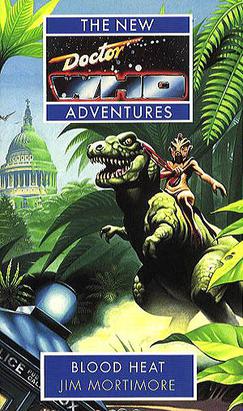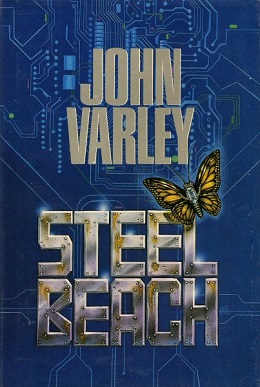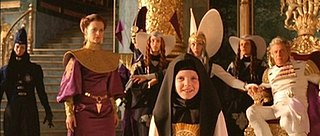
Alternate history is a subgenre of speculative fiction in which one or more historical events have occurred but are resolved differently than in actual history. As conjecture based upon historical fact, alternate history stories propose What if? scenarios about crucial events in human history, and present outcomes very different from the historical record. Some alternate histories are considered a subgenre of science fiction, or historical fiction.

A Fire Upon the Deep is a 1992 science fiction novel by American writer Vernor Vinge. It is a space opera involving superhuman intelligences, aliens, variable physics, space battles, love, betrayal, genocide, and a communication medium resembling Usenet. A Fire Upon the Deep won the Hugo Award in 1993, sharing it with Doomsday Book by Connie Willis.
Traveller is a science fiction role-playing game first published in 1977 by Game Designers' Workshop. Marc Miller designed Traveller with help from Frank Chadwick, John Harshman, and Loren Wiseman. Editions were published for GURPS, d20, and other role-playing game systems. From its origin and in the currently published systems, the game relied upon six-sided dice for random elements. Traveller has been featured in a few novels and at least two video games.
Galactic empires are a science fiction setting trope, in which most or all of the habitable planets in the setting's galaxy are ruled by a single centralized political entity. Galactic empires most frequently appear in works in the sub-genres of science fantasy and space opera, although they may appear in other sub-genres as well. Works featuring galactic empires may have them as the story's focus, chronicling the empire's growth and/or decline. Alternatively, they may merely serve as a backdrop against which the events of the story play out.
A parallel universe, also known as an alternate universe, parallel world, parallel dimension, alternate reality, or alternative dimension, is a hypothetical universe co-existing with one's own, typically distinct in some way. The sum of all potential parallel universes that constitute reality is often called the "multiverse". Another common term for a parallel universe is "another dimension", stemming from the idea that if the 4th dimension is time, the 5th dimension—a direction at a right angle to the fourth—is a direction into any of the alternate spacetime realities.

John Keith Laumer was an American science fiction author. Prior to becoming a full-time writer, he was an officer in the United States Air Force and a diplomat in the United States Foreign Service. His older brother March Laumer was also a writer, known for his adult reinterpretations of the Land of Oz. Frank Laumer, their youngest brother, is a historian and writer.
Arthur Bertram Chandler was an Anglo-Australian merchant marine officer, sailing the world in everything from tramp steamers to troop ships, but who later turned his hand to a second career as a prolific author of pulp science fiction. He also wrote under the pseudonyms of George Whitley, Andrew Dunstan and S.H.M. Many of his short stories draw on his extensive sailing background. In 1956, he emigrated to Australia and became an Australian citizen. By 1958 he was an officer on the Sydney–Hobart route. Chandler commanded various ships in the Australian and New Zealand merchant navies, including his service as the last master of the Australian aircraft carrier HMAS Melbourne; by law, the ship was required to have an officer on board while awaiting its towing to China to be broken up. Chandler wrote over 40 novels and 200 works of short fiction, winning the Australian Ditmar Awards for the short story "The Bitter Pill" and for three novels: False Fatherland, The Bitter Pill, and The Big Black Mark. One of Chandler's daughters, Jenny Chandler, married British horror fiction writer Ramsey Campbell. His other children were Penelope Anne Chandler and Christopher John Chandler.

The Virgin New Adventures are a series of novels from Virgin Publishing based on the British science-fiction television series Doctor Who. They continued the story of the Doctor from the point at which the television programme went into hiatus from television in 1989.
Imperium refers to a legal concept of authority in Roman antiquity

Princess-Majestrix Lilandra Neramani is a fictional character appearing in American comic books published by Marvel Comics, most commonly in association with the X-Men. She is the Empress, or Majestrix, of the Shi'ar Empire and shares a lifelong bond with the leader of the X-Men, Charles Xavier. She and Xavier were married, but their marriage was annulled after the Cassandra Nova incident.

The World Jones Made is a 1956 science fiction novel by American writer Philip K. Dick, examining notions of precognition, humanity, and politics. It was first published by Ace Books as one half of Ace Double D-150, bound dos-à-dos with Agent of the Unknown by Margaret St. Clair.

Blood Heat is an original novel written by Jim Mortimore and based on the long-running British science fiction television series Doctor Who. It features the Seventh Doctor, Ace and Bernice. A prelude to the novel, also penned by Mortimore, appeared in Doctor Who Magazine #205. This novel is the first novel in the "Alternate Universe cycle" which continues until No Future.

Crosstime Traffic is a series of books by Harry Turtledove.

The Psychotechnic League is a future history created by American science fiction writer Poul Anderson. The name "Psychotechnic League" was invented by Sandra Miesel during the early 1980s, to capitalize on Anderson's better-known Polesotechnic League future history. Anderson published 21 novels, novellas and short stories set in this future between 1949 and 1957, with a 22nd published in 1968.

The Great Time Machine Hoax is a science fiction novel by American writer Keith Laumer, an expansion of his novelette serialized in Fantastic Magazine under the title of "A Hoax in Time" from June–August 1963. For the novel version Laumer altered the framing story, rearranged the order of the narrative, and added a section not found in the earlier version. The book was originally published in hardcover by Simon & Schuster in September 1964, and in paperback by Pocket Books in August 1965. Later paperback editions were published by Award Books in 1974 and Ace Books in 1978 and 1984; the novel was also reprinted in the collection Keith Laumer: the Lighter Side, published by Baen Books in 2002, and in an omnibus edition with Poul Anderson's Inside Earth as A Hoax in Time/Inside Earth, published by Armchair Fiction in 2011. It has also been translated into French under the title L'Ordinateur Désordonné

Steel Beach is a 1992 science fiction novel by American writer John Varley.

"Sidewise in Time" is a science fiction short story by American writer Murray Leinster that was first published in the June 1934 issue of Astounding Stories. "Sidewise in Time" served as the title story for Leinster's second story collection in 1950.

A hypothetical military victory of the Axis powers over the Allies of World War II (1939–1945) is a common topic in speculative literature. Works of alternative history (fiction) and of counterfactual history (non-fiction) include stories, novels, performances, and mixed media that often explore speculative public and private life in lands conquered by the coalition, whose principal powers were Nazi Germany, Imperial Japan, and Fascist Italy.

Multiple organizations of the Dune universe dominate the political, religious, and social arena of the setting of Frank Herbert's Dune series of science fiction novels, and derivative works. Set tens of thousands of years in the future, the saga chronicles a civilization which has banned computers but has also developed advanced technology and mental and physical abilities through physical training, eugenics and the use of the drug melange. Specialized groups of individuals have aligned themselves in organizations focusing on specific abilities, technology and goals. Herbert's concepts of human evolution and technology have been analyzed and deconstructed in at least one book, The Science of Dune (2008). His originating 1965 novel Dune is popularly considered one of the greatest science fiction novels of all time, and is frequently cited as the best-selling science fiction novel in history. Dune and its five sequels by Herbert explore the complex and multilayered interactions of politics, religion, ecology and technology, among other themes.
We've a three-point civilization: the Imperial Household balanced against the Federated Great Houses of the Landsraad, and between them, the Guild with its damnable monopoly on interstellar transport.

Dictator is a historical novel by British author Robert Harris, published in 2015, which concludes his trilogy about the life of the Roman lawyer, politician and orator, Cicero. Dictator follows the first novel Imperium (2006) and the second novel Lustrum (2009). It is both a biography of Cicero and a tapestry of Rome in the time of Pompey, Crassus, Cato, Caesar, Clodius and ultimately Octavian.
















